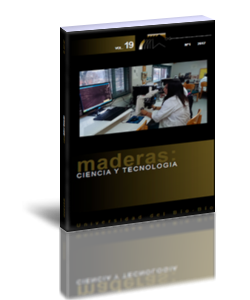Recovery of phenolic compounds from Eucalyptus wood wastes using ethanol-salt-based aqueous two-phase systems
Keywords:
Alcohol/salt system, aqueous two-phase systems, natural antioxidants, phenolic compounds, wood extraction.Abstract
In this work the partition behavior of phenols using ethanol-salt-based aqueous two phase systems (ATPS) was evaluated. The aim was the recovery of phenolic compounds with antioxidant capacity from eucalyptus wood industrial wastes. Experiments were planned to study the influence of several parameters on phenols partition, including type of inorganic salt (ammonium sulphate, a mixture of monopotassium phosphate and potassium diphosphate and potassium diphosphate), tie-lie lenght (TLL), volume ratio (Vr), settlement time and temperature. Phenols could be recovered preferently from the top or bottom phases depending on the salt used. It was demostrated that tie-lie lenght, volume ratio and temperature had influence on phenols partition. The highest total phenols yield 5,36 mg gallic acid equivalent (100 mg oven dried wood)-1 and FRAP antioxidant activity, 20 mmol AAE (100 g oven dried wood)-1, was obtained using ATPS formed by 40.6% (w/w) ethanol and 12% (w/w) of ammonium sulphate at 65ºC. Analysis of the extract by RP-HPLC-ESI-TOF confirmed the presence of the phenolic compounds with potential antioxidant activity, namely, ellagic acid, myricetin 3-O-rhamnoside and quercetin 3-glucoside.Downloads
References
Albertsson, P. 1986. Partition of cell particles and macromolecules. J. Wiley and Sons, New York.
Conde, E.; Cadahia, E.; Garcia Vallejo, M.C.; Diez, R. 1996. Composición polifenólica de madera, corteza y hojas de Eucalyptus camaldulensis, E. globulus y E. rudis. Investigación Agraria Sistemas y Recursos Forestales 5:333-350.
Espitia-Saloma, E.; Vázquez-Villegas, P.; Aguilar, O.; Rito-Palomares, M. 2014. Continuous aqueous two-phase systems devices for the recovery of biological products. Food and Bioproducts Processing 92:101-112.
Eyles, A.; Davies, N.W.; Mohammed, C. 2003. Wound wood formation in Eucalyptus globulus and Eucalyptus nitens: anatomy and chemistry. Canadian Journal of Forest Research 33:2331-2339.
Fernández-Agulló, A.; Freire, M.S.; González-Álvarez, J. 2015. Effect of the extraction technique on the recovery of bioactive compounds from eucalyptus (Eucalyptus globulus) wood industrial wastes. Industrial Crops and Products 64:105-113.
Gómez-Loredo, A.; Benavides, J.; Rito-Palomares, M. 2014. Partition behavior of fucoxanthin in ethanol-potassium phosphate two-phase systems. Journal of Chemical Technology and Biotechnology 89:1637-1645.
Jokic, S.; Velic, D.; Bilic, M.; Bucic-Kojic, A.; Plannic, M.; Tomas, S. 2010. Modelling of the process of solid-liquid extraction of total polyphenols from soybeans. Czech Journal of Food Sciences 28(3):206-212.
Lucena de Souza, R.; Barbosa, J.M.P.; Zanin, G.M.; Lobão, M.W.N.; Soares, C.M.F; Lima, A.S. 2010. Partitioning of porcine pancreatic lipase in a two-phase system of polyethylene glycol/potassium phosphate aqueous. Applied Biochemistry Biotechnology 161:288-300.
Moure, A.; Cruz, J.M.; Franco, D.; Dominguez, J.M.; Sineiro, J.; Domínguez, H.; Nuñez, M.J.; Parajo, J.C. 2001. Natural antioxidants from residual sources. Food Chemistry 72:145-171.
Ooi, C.W.; Tey, B.T.; Hii, S.L.; Kamal, S.M.M.; Lan, J.C.W.; Ariff, A. 2009. Purification of lipase derived from Burkholderia pseudomallei with alcohol/salt based aqueous two-phase systems. Proceedings of the Biochemical Society 44:1083-1087.
Reis, I.A.O.; Santos, S.B.; Santos, L.A.; Oliveira, N.; Freire, M.G.; Pereira, J.F.B.; Ventura, S.P.M.; Coutinho, J.A.P ; Soares, C.M.F ; Lima, A.S. 2012. Increased significance of food wastes: Selective recovery of added-value compounds. Food Chemistry 135:2453-2461.
Reis, I.A.O. ; Santos, S.B.; Pereira, F.D.S.; Sobral, C.R.S.; Freire, M.G.; Freitas, L.S.; Soares, C.M. F.; Lima, A. S. 2014. Extraction and recovery of rutin from acerola waste using alcohol-salt-based aqueous two-phase systems. Separation and Purification Technology 49:656-663.
Romani, A.; Pinelli, P.; Mulinacci, N.; Vincieri, F.F.; Tattini, M. 1999. Identification and quantitation of polyphenols in leaves of Myrtus communis L. Chromatographia 49:17-20.
Rosa, P.A.J.; Ferreira, I.F.; Azevedo, A.M.; Aires-Barros, M.R. 2010. Aqueous two-phase systems: A viable platform in the manufacturing of biopharmaceuticals. Journal of Chromatography A 1217:2296-2305.
Shen, S. ; Chang, Z.; Liu, H. 2006. Three-liquid-phase extraction systems for separation of phenol and p-nitrophenol from wastewater. Separation and Purification Technology 49: 217-222.
Simental-Martínez, J.; Montalvo-Hernándeza, B.; Rito-Palomares, M.; Benavides, J. 2014. Application of aqueous two-phase systems for the recovery of bioactive low-molecular weight compounds. Separation Science and Technology 49:1872-1882.
Singleton, V.L.; Rossi, J.A. 1965. Colorimetry of total phenolics with phosphomolybdic phosphotungstic acid reagents. American Journal of Enology and Viticulture 16:144-158.
Szollozi, R.; Szollozi-Varga, I. 2002. Total antioxidant power in some species of Labiatae (Adaptation of FRAP method). Acta Biologica Szegediensis 46(3-4):125-127.
Wang, Y.; Yan, Y.S.; Hu, S.P.; Han, J.; Xu, X.H. 2010. Phase diagrams of ammonium sulfate + ethanol/1-propanol/2-propanol + water aqueous two-phase systems at 298.15 K and correlation. Journal of Chemical & Engineering Data 55:876-881.
Wu, Y.; Wang, Y.; Zhang, W.; Han, J.; Liu, Y.; Hu, Y.; Ni, L. 2014. Extraction and preliminary purification of anthocyanins from grape juice in aqueous two-phase system. Separation and Purification Technology 124:170-178.
Xavier, L.; Freire, M.S.; Vidal-Tato, I.; González-Álvarez, J. 2014. Aqueous two-phase systems for the extraction of phenolic compounds from eucalyptus (Eucalyptus globulus) wood industrial wastes. Journal of Chemical Technology and Biotechnology 89:1772-1778.
Xavier, L.; Freire, M.S; Vidal-Tato, I.; González-Álvarez, J. 2015. Application of aqueous two phase systems based on polyethylene glycol and sodium citrate for the recovery of phenolic compounds from eucalyptus wood. Maderas-Ciencia y Tecnología 17:345-354.

































